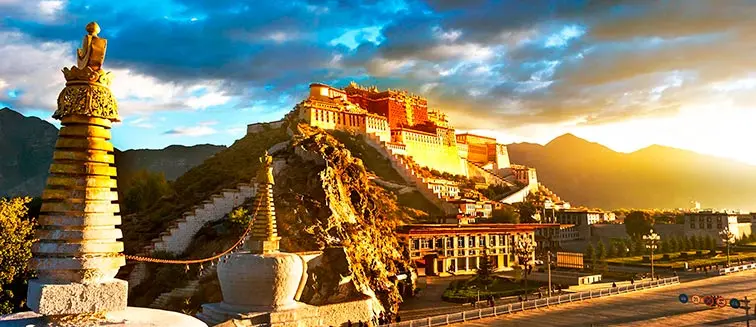Lhasa, Tibet
🏔️ Lhasa, Tibet – The Spiritual Heart of the Himalayas
Overview:
Lhasa, the capital of the Tibet Autonomous Region in China, is one of the most awe-inspiring and spiritually significant cities in the world. Surrounded by snow-capped mountains, Lhasa is known for its breathtaking landscapes and deeply rooted Tibetan Buddhist culture. Often referred to as the "City of Sun" due to its high altitude and abundant sunshine, Lhasa is home to iconic temples, monasteries, and landmarks like the Potala Palace and Jokhang Temple, which have drawn pilgrims for centuries. Lhasa is the spiritual heart of Tibet and a must-visit destination for those interested in Tibetan culture, history, and religion.
🏯 Top Attractions in Lhasa
1. Potala Palace
No visit to Lhasa is complete without seeing the Potala Palace, one of the most iconic landmarks in the world. This former winter residence of the Dalai Lama is perched high on a hill, offering panoramic views of the city. The palace is a masterpiece of Tibetan architecture and contains stunning murals, statues, and sacred relics. A UNESCO World Heritage Site, it is the epitome of Tibetan culture and history.
2. Jokhang Temple
Considered the holiest temple in Tibet, the Jokhang Temple is a spiritual center for Tibetan Buddhists. Pilgrims from all over Tibet come here to prostrate themselves before the temple’s Buddha statues. The temple complex is known for its rich history, exquisite architecture, and sacred atmosphere. The Barkhor Street surrounding the temple is a bustling area for shopping and traditional Tibetan experiences.
3. Sera Monastery
Sera Monastery, one of Tibet's "great three" Gelug monasteries, offers a fascinating insight into Tibetan Buddhist monastic life. Visitors can witness debates between monks, where they engage in a centuries-old tradition of verbal combat to clarify Buddhist teachings. The monastery is a tranquil place with impressive architecture and beautiful murals.
4. Norbulingka Palace
Often referred to as the “Summer Palace of Tibet,” Norbulingka was the traditional summer residence of the Dalai Lama. The palace and its surrounding gardens are serene and picturesque, offering a perfect escape from the bustling city. It’s a wonderful spot for a peaceful stroll, and the frescoes and Tibetan art on display are fascinating.
5. Yamdrok Lake
Located just outside of Lhasa, Yamdrok Lake is one of the most beautiful and sacred lakes in Tibet. Surrounded by snow-capped mountains, the turquoise waters of the lake are a serene and peaceful sight. Many pilgrims consider the lake to be holy, and it’s a great spot for a day trip from Lhasa to experience Tibet’s natural beauty.
🛕 Spiritual & Cultural Experience
1. Pilgrimages & Prayer
Lhasa is the spiritual capital of Tibet, and pilgrims flock to its many monasteries and temples. The Barkhor Circuit, a pilgrimage route around the Jokhang Temple, is a must-see. Here, you’ll see devout Tibetans walking clockwise, spinning prayer wheels, and chanting mantras. The spiritual energy in Lhasa is palpable, and participating in these rituals can offer a profound cultural experience.
2. Tibetan Festivals
If you’re lucky enough to visit during one of Tibet's many festivals, you’ll experience the vibrant and colorful traditions of Tibetan culture. The Tibetan New Year (Losar) and the Shoton Festival are especially notable, with lively celebrations, traditional dances, and religious rituals that take place across the city.
3. Tibetan Cuisine
Tibetan cuisine is hearty and flavorful, designed to sustain people in the high-altitude environment. Don’t miss out on momo (steamed dumplings), thukpa (noodle soup), and yak meat dishes. For a truly authentic experience, try butter tea (a traditional Tibetan drink made from tea, yak butter, and salt) and tsampa, a barley flour dish that is a staple of Tibetan cuisine.
🗺️ Best Time to Visit Lhasa
1. Spring (April to June):
The weather in spring is relatively mild, with the snow beginning to melt. This is an excellent time for exploring Lhasa, as the city is less crowded, and the landscapes are lush and vibrant.
2. Summer (July to August):
Summer brings warmer temperatures, but it also attracts more tourists, especially during the Tibetan festivals. It's the best time to experience the vibrant culture of Tibet.
3. Autumn (September to November):
Autumn offers crisp air and clear skies, making it a fantastic time to visit for outdoor exploration. The temperatures are pleasant, and the landscapes are stunning with the changing colors of the leaves.
4. Winter (December to February):
Winter in Lhasa can be extremely cold, with snow covering the city. However, it’s a great time for those looking to experience Lhasa without the crowds. The spiritual atmosphere is more serene, and you can enjoy the peace and solitude of the temples and monasteries.
🏨 Accommodation in Lhasa
1. Luxury:
-
St. Regis Lhasa Resort: A luxurious hotel with a blend of traditional Tibetan architecture and modern amenities. Located near the Potala Palace, it offers excellent views and top-notch service.
-
InterContinental Lhasa Paradise: A five-star hotel known for its stunning design and close proximity to major attractions.
2. Mid-Range:
-
Lhasa Hotel: A more affordable option that still provides comfortable rooms and great service. It’s a short distance from major cultural sites like Jokhang Temple and Barkhor Street.
-
Gyalthang Dzong Hotel: Known for its traditional Tibetan architecture and welcoming atmosphere, it’s a great choice for visitors seeking authenticity.
3. Budget:
-
Tashi Choeta Hotel: A good budget option for travelers looking for basic accommodations without compromising comfort.
-
Lhasa Yarlung Hotel: Located in the center of the city, this hotel offers a budget-friendly experience with easy access to major attractions.


